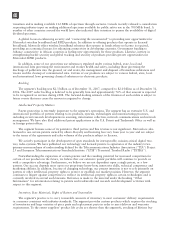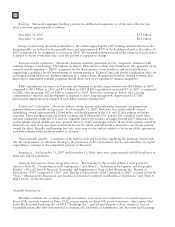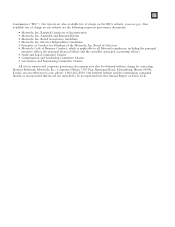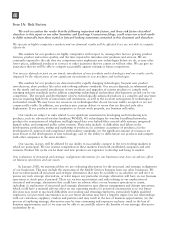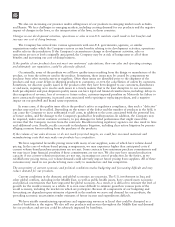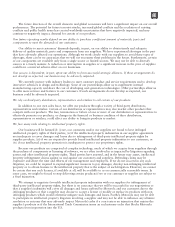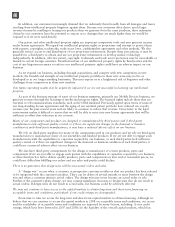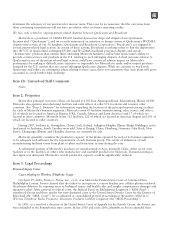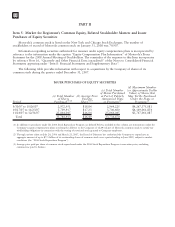Motorola 2007 Annual Report Download - page 32
Download and view the complete annual report
Please find page 32 of the 2007 Motorola annual report below. You can navigate through the pages in the report by either clicking on the pages listed below, or by using the keyword search tool below to find specific information within the annual report.
The value of our investments in the securities of various companies fluctuates and it may be difficult for us to
realize the value of these investments.
We hold a portfolio of investments in various companies. Since the majority of these securities represent
investments in technology companies, the fair market values of these securities are subject to significant price
volatility. In addition, the realizable value of these securities is subject to market and other conditions.
We also have invested in numerous privately-held companies, many of which can still be considered in startup
or developmental stages. These investments are inherently risky as the market for the technologies or products they
have under development are typically in the early stages and may never materialize. We could lose all or
substantially all of the value of our investments in these companies, and in some cases have.
The Sigma Fund, an investment fund owned by the Company, holds U.S. Dollar-denominated debt obligations
which include corporate bonds and asset- and mortgage-backed securities. The fair value of these holdings may
experience temporary or other-than-temporary declines due to the widening credit spreads in several debt market
segments and impairment if the underlying debtor should default on its obligations.
If we are unable to purchase sufficient credit insurance, our business may be negatively impacted.
We purchase a large amount of credit insurance to mitigate some of our credit risks. Our ability to sell certain
of our receivables could be negatively impacted if we are not able to continue to purchase credit insurance in
certain countries and in sufficient quantities. In addition, our success in certain countries may be dependent on our
ability to obtain sufficient credit insurance.
It may be difficult for us to recruit and retain the types of highly-skilled employees that are necessary to remain
competitive.
Competition for key technical personnel in high-technology industries is intense. We believe that our future
success depends in large part on our continued ability to hire, assimilate, retain and leverage the skills of qualified
engineers and other highly-skilled personnel needed to compete and develop successful new products. We may not
be as successful as our competitors at recruiting, assimilating, retaining and utilizing these highly-skilled personnel.
In particular, we may have more difficulty attracting or retaining highly-skilled personnel during periods of poor
operating performance.
The unfavorable outcome of litigation pending or future litigation could materially impact the Company.
Our financial results could be materially adversely impacted by unfavorable outcomes to any pending or future
litigation. See “Item 3—Legal Proceedings.” There can be no assurances as to the favorable outcome of any litigation.
In addition, it can be very costly to defend litigation and these costs could negatively impact our financial results.
We are subject to a wide range of product regulatory and safety, consumer, worker safety and environmental laws.
Our operations and the products we manufacture and/or sell are subject to a wide range of global laws.
Compliance with existing or future laws could subject us to future costs or liabilities, impact our production
capabilities, constrict our ability to sell, expand or acquire facilities, and generally impact our financial
performance. Some of these laws relate to the use, disposal, clean up of, and exposure to hazardous substances. In
the United States, laws often require parties to fund remedial studies or action regardless of fault. Motorola
continues to incur disposal costs and has ongoing remediation obligations. Changes to U.S. environmental laws or
our discovery of additional obligations under these laws could have a negative impact on Motorola.
Over the last several years, laws focused on: the energy efficiency of electronic products and accessories;
recycling of both electronic products and packaging; and reducing or eliminating certain hazardous substances in
electronic products have expanded significantly. Laws pertaining to accessibility features of electronic products,
standardization of connectors and power supplies, sound levels of music playing devices, and other aspects are also
proliferating.
These laws impact our products and make it more expensive to manufacture and sell product. It may also be
difficult to comply with the laws in a timely way and we may not have compliant products available in the
quantities requested by our customers, thereby impacting our sales and profitability.
We expect these trends to continue. In addition, we anticipate increased demand to meet voluntary criteria
related to reduction or elimination of certain hazardous constituents from products, increasing energy efficiency,
and providing additional accessibility.
24


